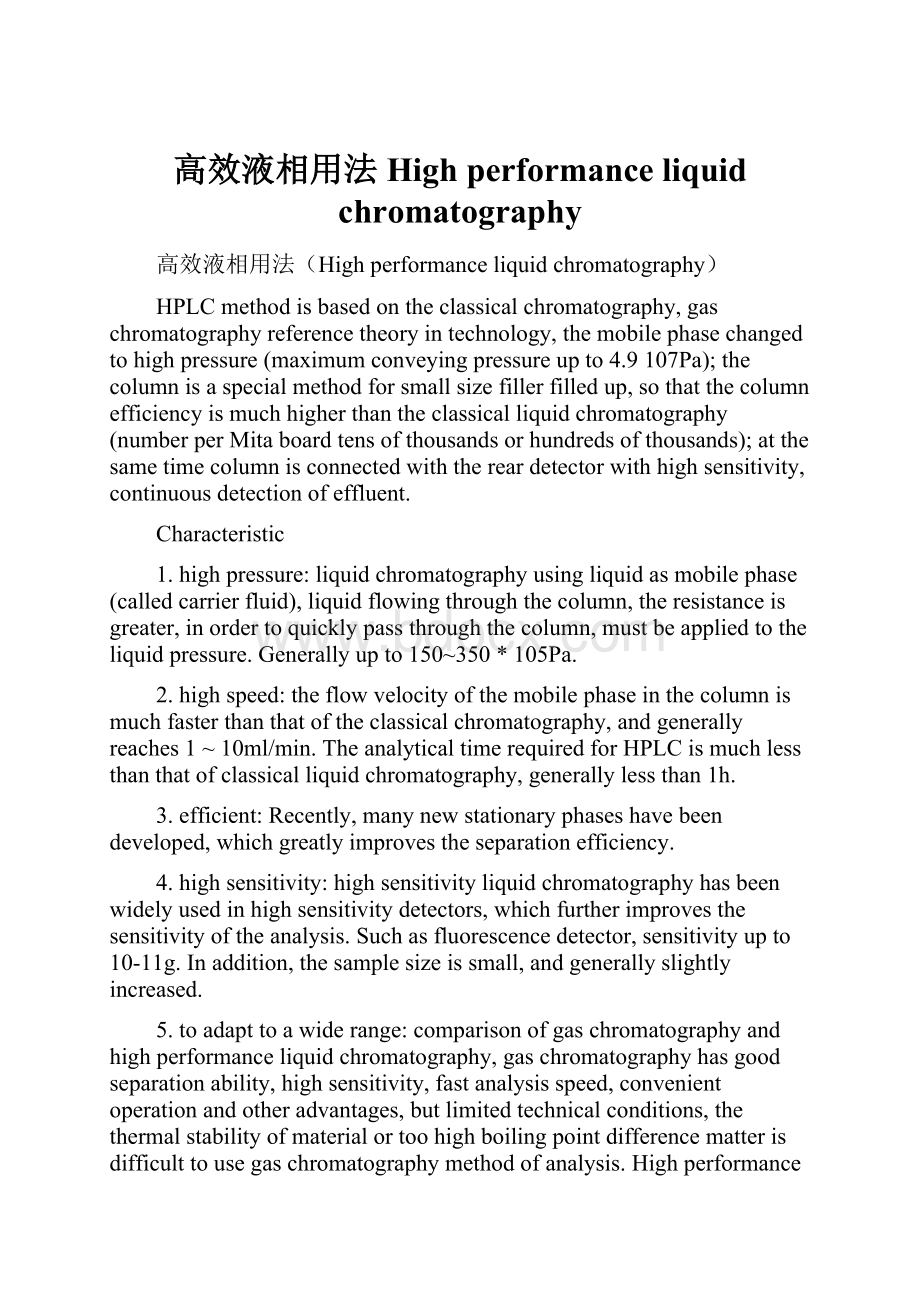 高效液相用法High performance liquid chromatography.docx
高效液相用法High performance liquid chromatography.docx
- 文档编号:10156231
- 上传时间:2023-02-08
- 格式:DOCX
- 页数:8
- 大小:19.93KB
高效液相用法High performance liquid chromatography.docx
《高效液相用法High performance liquid chromatography.docx》由会员分享,可在线阅读,更多相关《高效液相用法High performance liquid chromatography.docx(8页珍藏版)》请在冰豆网上搜索。

高效液相用法Highperformanceliquidchromatography
高效液相用法(Highperformanceliquidchromatography)
HPLCmethodisbasedontheclassicalchromatography,gaschromatographyreferencetheoryintechnology,themobilephasechangedtohighpressure(maximumconveyingpressureupto4.9107Pa);thecolumnisaspecialmethodforsmallsizefillerfilledup,sothatthecolumnefficiencyismuchhigherthantheclassicalliquidchromatography(numberperMitaboardtensofthousandsorhundredsofthousands);atthesametimecolumnisconnectedwiththereardetectorwithhighsensitivity,continuousdetectionofeffluent.
Characteristic
1.highpressure:
liquidchromatographyusingliquidasmobilephase(calledcarrierfluid),liquidflowingthroughthecolumn,theresistanceisgreater,inordertoquicklypassthroughthecolumn,mustbeappliedtotheliquidpressure.Generallyupto150~350*105Pa.
2.highspeed:
theflowvelocityofthemobilephaseinthecolumnismuchfasterthanthatoftheclassicalchromatography,andgenerallyreaches1~10ml/min.TheanalyticaltimerequiredforHPLCismuchlessthanthatofclassicalliquidchromatography,generallylessthan1h.
3.efficient:
Recently,manynewstationaryphaseshavebeendeveloped,whichgreatlyimprovestheseparationefficiency.
4.highsensitivity:
highsensitivityliquidchromatographyhasbeenwidelyusedinhighsensitivitydetectors,whichfurtherimprovesthesensitivityoftheanalysis.Suchasfluorescencedetector,sensitivityupto10-11g.Inaddition,thesamplesizeissmall,andgenerallyslightlyincreased.
5.toadapttoawiderange:
comparisonofgaschromatographyandhighperformanceliquidchromatography,gaschromatographyhasgoodseparationability,highsensitivity,fastanalysisspeed,convenientoperationandotheradvantages,butlimitedtechnicalconditions,thethermalstabilityofmaterialortoohighboilingpointdifferencematterisdifficulttousegaschromatographymethodofanalysis.Highperformanceliquidchromatography(HPLC)requiresthatthesamplebemadeintoasolutionwithouttheneedforgasification,sothatitisnotsubjecttothevolatilityofthesample.Forhighboilingpoint,poorthermalstability,relativelyhighmolecularweight(morethan400)oforganicmatter(thesesubstancesaccountedforalmost75%ofthetotalorganicmatter~80%)principlecanbeappliedbyhighperformanceliquidchromatographyforseparationandanalysis.Accordingtostatistics,intheknowncompounds,gaschromatographycanaccountforabout20%,whileliquidchromatographycanaccountforabout70to80%.
Highperformanceliquidchromatographystationaryphaseaccordingtotheirnaturecanbedividedintohighhydrophobicgelchromatography,high-performanceliquidchromatography,reversed-phasehighperformanceliquidchromatography,ionexchangehighperformanceliquidchromatography,highperformanceliquidchromatographyandhighaffinityliquidchromatographyandothertypesoffocus.Theprincipleofseparationandanalysisofvariouscompoundsbyhighperformanceliquidchromatographyissimilartotheprincipleofcommonliquidchromatography.ThedifferenceisthatHPLCissensitive,fast,highresolutionandreproducible,andhastobecarriedoutinchromatograph.
Maintypesandseparationprincipleofhighperformanceliquidchromatography
Accordingtotheseparationmechanism,HPLCcanbedividedintothefollowingmaintypes:
1.liquidliquidpartitionchromatography(Liquid-liquid,Partition,Chromatography)andchemicalbondedChromatography(ChemicallyBondedPhase)
Themobilephaseandthestationaryphasearebothliquids.Thereisanobviousinterfacebetweenthemobilephaseandthestationaryphase,whicharemutuallyinsoluble(differentpolarityandavoidingthelossofthestationaryliquid).Whenthesampleentersthecolumn,thesoluteisdistributedbetweentwophases.Whenbalanced,submittothelower:
Intheformula,theconcentrationofCS-soluteinthestationaryphase;theconcentrationofcm--soluteinthemobilephase;thevolumeoftheVs-stationaryphase;andthevolumeofVm-Mobilephase.LLPCandGPChavesimilarities,thatis,theorderofseparationdependsonK,andtheretentionoflargecomponentsofKislarge,buttherearealsodifferences.InGPC,theflowrelativetoKhaslittleeffect,andtheLLPCflowhasagreaterinfluenceonK.
A.NormalPhaseliquidChromatography:
thepolarityofthemobilephaseislessthanthepolarityofthestationaryliquid.
B.reversedphaseliquidliquidpartitionchromatography(ReversePhaseliquidChromatography):
thepolarityofmobilephaseisgreaterthanthatofstationaryliquid.
C.
Liquid-liquidpartitionchromatographydisadvantages:
Althoughthemobilephaseandstationaryphasepolarityrequirementsarecompletelydifferent,butfixedliquidinthemobilephaseisstilldissolved;themobilephasebymechanicalshockcolumnforce,willcausethelossofstationaryliquid.Thechemicalbondattheendofthe70sdevelopmentofthelastcenturystationaryphase(seebelow),thiscanbeovercome.Itisnowwidelyused(70~80%).
2.liquidsolidchromatography
Themobilephaseisliquid,andthestationaryphaseisadsorbent(suchassilicagel,alumina,etc.).Thisisbasedontheadsorptionofsubstancestoseparate.Themechanismis:
whenthesampleentersthechromatographiccolumn,thesolutemolecule(X)andsolventmolecules(S)occurrenceofcompetitiveadsorptionontheadsorbentsurfaceactivecenter(notintothesample,alloftheadsorbentadsorptionactivecenterisS),whichcanbeexpressedasfollows:
Xm+nSa+nSmhistoryXa
Formula:
solutemoleculesinXm--mobilephase;solventmoleculesinSa--stationaryphase;solutemoleculesinXa--stationaryphase;solventmoleculesinSm--mobilephase.
Whentheadsorptioncompetitionreactionreachesequilibrium:
K=[Xa][Sm]/[Xm][Sa]
Formula:
Kistheequilibriumconstantofadsorption.[discussion:
thebiggertheK,thegreatertheretentionvalue.]
3.ionexchangechromatography(Ion-exchange,Chromatography)
IECisanionicexchangerusedasastationaryphase.IECisbasedonreversibleexchangeofionizableionsonionexchangeresinswithsoluteionswiththesamechargeinthemobilephase,whichareseparatedbyexchangeagentswithdifferentaffinities.
Takinganionexchangersasanexample,theirexchangeprocesscanbeexpressedasfollows:
X-(solvent)+(-R4N+Cl-resin)(-R4N+=X-+Cl-resin)(solvent)
Whentheexchangereachesequilibrium:
KX=[-R4N+X-][Cl-]/[-R4N+Cl-][X-]
Partitioncoefficient:
DX=[-R4N+X-]/[X-]=KX[-R4N+Cl-]/[Cl-]
[discussion:
relationshipbetweenDXandretentionvalue]
Anysubstancethatcanionizeinasolventcanusuallybeseparatedbyionexchangechromatography.
4.ionpairchromatography(Ion,Pair,Chromatography)
Isakindofionchromatography(ormore)ioninsteadofsolutemolecules(calledthechargeofionsandcounterions)addedtothemobilephaseorthestationaryphase,whichcombinedwiththeformationofhydrophobicsoluteionionpaircompounds,soastocontroltheretentionbehaviorofsoluteions.Theprinciplecanbeexpressedinthelowerform:
X++Y-=X+Y-aqueousaqueousorganicphase
Type:
X+-phaseflowofaqueousorganicionstobeseparated(butalsocationic);Y-phase-phaseflowoppositelychargedions(suchashydrogenoxidationoffourtetrabutylammoniumhydroxide,sixteenalkyltrimethylammoniumion;etc.)ontheformationofX+Y---compounds.
Whenthebalanceisreached:
KXY=[X+Y-]/X+][Y-]aqueousaqueousorganicphase
Bydefinition,thepartitioncoefficientis:
DX=[X+Y-]=KXY/X+]aqueousorganicphase[Y-]inaqueousphase
[discussion:
relationshipbetweenDXandretentionvalue]
Ionpairchromatography(especiallyprimaryRP)solvestheproblemofseparatingthemixturebeforeitisdifficulttoseparate,suchasacid,alkaliandionicandnonionicmixtures,especiallytheseparationofsomebiochemicalsamplessuchasnucleicacids,nucleosides,alkaloidsanddrugsetc..
5.ionchromatography(Ion,Chromatography)
Theion-exchangeresinisusedasstationaryphase,andtheelectrolytesolutionismobilephase.Usingaconductivitydetectorasauniversaldetector,asuppressioncolumnwassetuptoeliminatetheinterferenceofthestrongelectrolytebackgroundionsinthemobilephaseontheconductivitydetector.Thereactionprincipleofthesamplecomponentontheseparatingcolumnandtherestrainingcolumnisthesameasthatoftheionexchangechromatography.
Takinganionexchangeresin(R-OH)asstationaryphaseandseparatinganions(suchasBr-)asanexample.WhentheanionBr-withthemobilephase(NaOH)entersthechromatographiccolumn,thefollowingexchangereactionoccurs(elutionisthereverseprocessoftheexchangereaction):
Suppressreactionsonthecolumn:
r-h++na+,oh-===r-na++h2o
r-h++na+br-===r-na++h+br-------
可见,通过抑制柱将洗脱液转变成了电导值很小的水,消除了本底电导的影响;试样阴离子br-则被转化成了相应的酸h+br-,可用电导法灵敏的检测.
离子色谱法是溶液中阴离子分析的最佳方法.也可用于阳离子分析.
6.空间排阻色谱法(stericexclusionchromatography)
空间排阻色谱法以凝胶(gel)为固定相.它类似于分子筛的作用,但凝胶的孔径比分子筛要大得多,一般为数纳米到数百纳米.溶质在两相之间不是靠其相互作用力的不同来进行分离,而是按分子大小进行分离.分离只与凝胶的孔径分布和溶质的流动力学体积或分子大小有关.试样进入色谱柱后,随流动相在凝胶外部间隙以及孔穴旁流过.在试样中一些太大的分子不能进入胶孔而受到排阻,因此就直接通过柱子,首先在色谱图上出现,一些很小的分子可以进入所有胶孔并渗透到颗粒中,这些组分在柱上的保留值最大,在色谱图上最后出现.
高效液相色谱仪主要有进样系统、输液系统、.分离系统、检测系统和数据处理系统,下面将分别叙述其各自的组成与特点.
1.进样系统
一般采用隔膜注射进样器或高压进样间完成进样操作,进样量是恒定的.这对提高分析样品的重复性是有益的.
2.输液系统
该系统包括高压泵、流动相贮存器和梯度仪三部分.高压泵的一般压强为l.47~4.4x107pa,流速可调且稳定,当高压流动相通过层析柱时,可降低样品在柱中的扩散效应,可加快其在柱中的移动速度,这对提高分辨率、回收样品、保持样品的生物活性等都是有利的.流动相贮存错和梯度仪,可使流动相随固定相和样品的性质而改变,包括改变洗脱液的极性、离子强度、ph值,或改用竞争性抑制剂或变性剂等.这就可使各种物质(即使仅有一个基团的差别或是同分异构体)都能获得有效分离.
3.分离系统
该系统包括色谱柱、连接管和恒温器等.色谱柱一般长度为10~50cm(需要两根连用时,可在二者之间加一连接管)
- 配套讲稿:
如PPT文件的首页显示word图标,表示该PPT已包含配套word讲稿。双击word图标可打开word文档。
- 特殊限制:
部分文档作品中含有的国旗、国徽等图片,仅作为作品整体效果示例展示,禁止商用。设计者仅对作品中独创性部分享有著作权。
- 关 键 词:
- 高效液相用法High performance liquid chromatography 高效 用法 High
 冰豆网所有资源均是用户自行上传分享,仅供网友学习交流,未经上传用户书面授权,请勿作他用。
冰豆网所有资源均是用户自行上传分享,仅供网友学习交流,未经上传用户书面授权,请勿作他用。


 《JAVA编程基础》课程标准软件16级.docx
《JAVA编程基础》课程标准软件16级.docx
